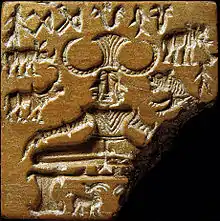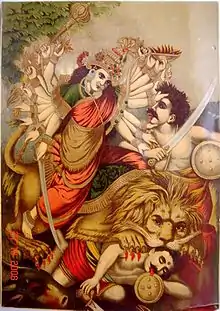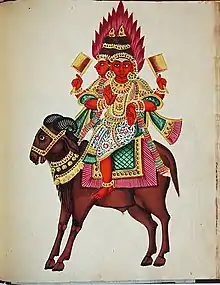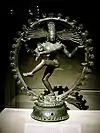Pashupati seal
The Pashupati Seal is a steatite seal that was discovered at the Mohenjo-daro archaeological site of the Indus Valley Civilization. The seal depicts a seated figure that is possibly tricephalic (having three heads). It was once thought to be ithyphallic, an interpretation that is now mostly discarded. The man has a horned headdress and is surrounded by animals. He may represent a horned deity.[1] The seal is kept in the National Museum of India in New Delhi.[2][3]

It has one of the more complicated designs in the thousands of seals found from the Indus Valley Civilization, and is unusual in having a human figure as the main and largest element; in most seals this is an animal. It has been claimed to be one of the earliest depictions of the Hindu god Shiva, or a "proto-Shiva" deity. The name given to the seal, "pashupati", meaning "lord of animals", is one of Shiva's epithets. It has also been associated with the Vedic god Rudra, generally regarded as an early form of Shiva. Rudra is associated with asceticism, yoga, and linga; regarded as a lord of animals; and Shiva may be depicted with three heads. The figure has often been connected with the widespread motif of the Master of Animals found in ancient Near Eastern and Mediterranean art, and the many other traditions of horned deities.[1]
Discovery and description

The seal was uncovered in 1928-29, in Block 1, Southern Portion of the DK-G Area of Mohenjo-daro, at a depth of 3.9 meters below the surface.[5] Ernest J. H. Mackay, who directed the excavations at Mohenjo-daro, and dated the seal to the Intermediate I Period (now considered to fall around 2350-2000 BCE) in his 1937-38 report in which the seal is numbered 420, giving it its alternate name.[6]

The seal is carved in steatite and measures 3.56 cm by 3.53 cm, with a thickness of 0.76 cm. It has a human figure at the centre seated on a platform and facing forward. The legs of the figure are bent at the knees with the heels touching and the toes pointing downwards. The arms extend outwards and rest lightly on the knees, with the thumbs facing away from the body. Eight small and three large bangles cover the arms. The chest is covered with what appear to be necklaces, and a double band wraps around the waist. The figure wears a tall and elaborate headdress with central fan-shaped structure flanked by two large striated horns. The human figure is surrounded by four wild animals: an elephant and a tiger to its one side, and a water buffalo and a rhinoceros on the other. Under the dais are two deer or ibexes looking backwards, so that their horns almost meet the center. At the top of the seal are seven pictographs, with the last apparently displaced downwards for lack of horizontal space.[7][8]
Interpretations
Marshall's identification with proto-Shiva
An early description and analysis of the seal's iconography was provided by archaeologist John Marshall who had served as the Director-General of the Archaeological Survey of India and led the excavations of the Indus Valley sites. In addition to the general features of the seal described above, he also saw the central figure as a male deity; as three-faced, with a possible fourth face towards the back; and, as ithyphallic, while conceding that what appeared to be the exposed phallus could instead be a tassel hanging from the waistband. Most significantly he identified the seal as an early prototype of the Hindu god Shiva (or, his Vedic predecessor, Rudra), who also was known by the title Pashupati ('lord or father of all the animals') in historic times.[9] In a 1928–29 publication, Marshall summarized his reasons for the identification as follows:
My reasons for the identification are four. In the first place the figure has three faces and that Siva was portrayed with three as well as with more usual five faces, there are abundant examples to prove. Secondly, the head is crowned with the horns of a bull and the trisula are characteristic emblems of Siva. Thirdly, the figure is in a typical yoga attitude, and Siva [sic] was and still is, regarded as a mahayogi—the prince of Yogis. Fourthly, he is surrounded by animals, and Siva is par excellence the "Lord of Animals" (Pasupati)—of the wild animals of the jungle, according to the Vedic meaning of the word pashu, no less than that of domesticated cattle.[5]
Later, in 1931, he expanded his reasons to include the fact that Shiva is associated with the phallus in the form of linga, and that in medieval art he is shown with deer or ibexes, as are seen below the throne on the seal.[9][10] Marshall's analysis of the Indus Valley religion, and the Pashupati seal in particular, was very influential and widely accepted for at least the next two generations. For instance, Herbert Sullivan, wrote in 1964 that Marshall's analysis "has been accepted almost universally and has greatly influenced scholarly understanding of the historical development of Hinduism".[11] Writing in 1976, Doris Srinivasan introduced an article otherwise critical of Marshall's interpretation by observing that "no matter what position is taken regarding the seal's iconography, it is always prefaced by Marshall's interpretation. On balance the proto-Śiva character of the seal has been accepted."[12] Thomas McEvilley noted, in line with Marshall, that the central figure was in the yoga pose Mulabandhasana, quoting the Kalpa Sutra's description "a squatting position with joined heels" used with meditation and fasting to attain infinite knowledge (kevala).[13] And Alf Hiltebeitel noted in 2011 that, following Marshall's analysis, "nearly all efforts at interpreting the [Indus Valley] religion have centered discussion around [the Pashupati seal] figure".[14] A lot of discussion has taken place about this seal.[15] While Marshall's work has earned some support, many critics and even supporters have raised several objections.[16]
Doris Srinivasan's reinterpretation
Doris Srinivasan, a professor of Indian studies, raised objections to Marshall's identification, and provided a new interpretation for the figure, where she postulated the lateral projections were cow-like ears rather than faces. In 1975-76, she published a journal article titled 'The So-Called Proto-śiva Seal from Mohenjo-Daro: An Iconological Assessment' in the academic journal Archives of Asian Art.[17] In 1997, she reiterated her views in a book titled Many Heads, Arms, and Eyes: Origin, Meaning, and Form of Multiplicity in Indian Art.

According to her, the two extra faces could be reinterpreted as possible ears, and the central face has predominant bovine features. She has drawn similarities between the central figure of seal 420, and other artefacts from the Indus Valley such as the horned mask from Mohenjo-Daro, the terracotta bull from Kalibangan, and the depiction of a horned deity on a water pitcher from the archaeological site of Kot Diji. She has also noted that the yogic posture of the figure is repeated on a number of other seals and sealings, some of which indicate that the figure receives worship. On the basis of these observations, she suggests that the figure of seal 420 could be a divine buffalo-man.[18]
Dravidian Interpretations
Scholars who consider the Indus Valley Civilisation to be associated with Dravidian culture have offered other interpretations. According to Alf Hiltebeitel, Professor of Religion, History, and Human Sciences at George Washington University,[19] the horned figure could be identified with Mahishasura, the buffalo demon enemy of the Hindu goddess Durga. He has also argued that the tiger depicted in the seal could represent the goddess Durga who is often depicted as ridding a tiger (or a lion) in the Hindu pantheon. He also suggested that the surrounding animals could represent the vahanas (vehicles, mounts) of deities for the four cardinal directions.[20][21]
Herbert Sullivan from Duke University[22] interpreted the figure as a female goddess on the grounds that the so-called erect phallus actually represents a girdle, a feature he had found only on female figurines.[11] The American archaeologist Walter Fairservis tried to translate what he considered to be a Dravidian inscription, and was of the view that the seal could be identified with Anil, the paramount chief of four clans represented by the animals. The Finnish Indologist, Asko Parpola has suggested that the yogic pose could be an imitation of the Proto-Elamite way of representing seated bulls. He attempted to translate the inscription which he considers to be an early form of Dravidian, and found that the figure represents a servant of an aquatic deity.[23] He finds that the animals depicted on the seal best resemble those associated with the Hindu god Varuna who could be associated with the aquatic themes which are prominent in the Indus religion.[21]
Vedic Interpretations

There are some scholars who think the seal represents a Vedic deity, and believe that this points to an Indo-Aryan identity of the Indus Valley Civilisation. The Indian archaeologist, S.R. Rao who is credited with discoveries of a number of Harappan sites, identified the figure in the seal with the Vedic deity Agni. He attempted to translate the text and claimed that the evidence pointed to the three-headed blazing, fire god Agni who belongs to the Vedic pantheon. The animals represent the various clans which accepted the supremacy of Agni.
E. Richter-Ushanas identified the figure with the sage Rishyasringa who was born with horns, and who officiated the sacrifice of King Dasaratha in the ancient Indian epic Ramayana. The considers the four animals to be a representation of the four seasons, and found similar motifs on the Gundestrup cauldron discovered in Denmark. Other scholars such as Talageri, Rajaram and Frawley, have postulated that the cauldron presents compelling evidence towards India as the home of the Indo-European people. S.P. Singh identified the figure with the Hindu god Rudra who is associated with the storm and the hunt. He identified the surrounding animals with the Maruts who are storm deities and sons of Rudra. His argument for this identification is based on hymn 64 of the first mandala (book) of the Rigveda which compares the Maruts to various animals, including a bull, an elephant, a lion, a deer, and a serpent.[24] M.V.N. Krishna Rao identified the figure with the Hindu god Indra. He argued that the tiger could be ignored since it's much larger than the other animals, and the two deer could also be ignored since they were seated under the table. Then he combined the first phoneme of each of the animals, and the word 'nara' meaning man, and arrived at the term 'makhanasana' which is an epithet of Indra.[21]
See also
References
- Werness, Hope B., Continuum Encyclopedia of Animal Symbolism in World Art, p. 270, 2006, A&C Black, ISBN 0826419135, 9780826419132, google books
- "Walk back to the past: Take a tour of the Harappan civilisation in a Delhi museum". Hindustan Times. 29 July 2017.
- "Pre-History & Archaeology". National Museum India.
- Kenoyer, Jonathan Mark. "Mohenjo-daro: Introduction". Archived from the original on 2013-12-01.
- Mackay 1928–29, pp. 74-75.
- Mackay 1937–38, plate XCIV; no. 420.
- Possehl 2002, p. 141.
- Marshall 1931, p. 52.
- Marshall 1931, pp. 52-57.
- McEvilley 1981, pp. 45-46.
- Sullivan 1964.
- Srinivasan 1975–76, p. 47.
- McEvilley 1981, pp. 47-51.
- Hiltebeitel 2011, p. 399.
- Bryant, Edwin, p.163
- See e. g. James G. Lochtefeld, The Illustrated Encyclopedia of Hinduism, vol. 2: N–Z. The Rosen Publishing Group, New York 2002, p. 633, who doubts the connection of the seal to Shiva, given the supposedly late age of the god.
- Srinivasan, Doris (1975–1976). "The So-Called Proto-śiva Seal from Mohenjo-Daro: An Iconological Assessment". Archives of Asian Art. 29: 47–58. JSTOR 20062578.
- Srinivasan, Doris (1997). Many Heads, Arms, and Eyes: Origin, Meaning, and Form of Multiplicity in Indian Art. 181: Brill. ISBN 9004107584.CS1 maint: location (link)
- Hiltebeitel, Alf. "Alf Hiltebeitel". Columbian College of Arts and Sciences.
- Hiltebeitel 2011, pp. 399-432.
- Bryant, Edwin (2001). The Quest for the Origins of Vedic Culture: The Indo-Aryan Migration Debate. Oxford University Press. pp. 163. ISBN 0199881332.
- Sullivan, Herbert (1964). "A re-examination of the religion of the Indus civilization". Google Books.
- Ratnagar, Shereen (2006). Trading Encounters: From the Euphrates to the Indus in the Bronze Age. Oxford University Press. p. 25. ISBN 9780195666038.
- "Rigveda, Book I, Hymn 64". Wikisource.
Sources
- Hiltebeitel, Alf (2011). "The Indus Valley "Proto-Śiva", Reexamined through Reflections on the Goddess, the Buffalo, and the Symbolism of vāhanas". In Adluri, Vishwa; Bagchee, Joydeep (eds.). When the Goddess was a Woman: Mahabharata Ethnographies - Essays by Alf Hiltebeitel. BRILL. ISBN 978-90-04-19380-2.
- Mackay, Ernest John Henry (1928–29). "Excavations at Mohenjodaro". Annual Report of the Archaeological Survey of India: 67–75.
- Mackay, Earnest John Henry (1937–38). Further excavations at Mohenjo-Daro : being an official account of archaeological excavations at Mohenjo-Daro carried out by the Government of India between the years 1927 and 1931. Delhi: Government of India.
- McEvilley, Thomas (1981). "An Archaeology of Yoga". RES: Anthropology and Aesthetics. 1 (1): 44–77. doi:10.1086/RESv1n1ms20166655. JSTOR 20166655. S2CID 192221643.
- Marshall, John (1931). Mohenjo-Daro and the Indus Civilization: Being an Official Account of Archaeological Excavations at Mohenjo-Daro Carried Out by the Government of India Between the Years 1922 and 1927. Asian Educational Services. ISBN 978-81-206-1179-5.
- Possehl, Gregory L. (2002). The Indus Civilization: A Contemporary Perspective. Rowman Altamira. ISBN 978-0-7591-1642-9.
- Srinivasan, Doris (1975–76). "The So-Called Proto-śiva Seal from Mohenjo-Daro: An Iconological Assessment". Archives of Asian Art. 29: 47–58. JSTOR 20062578.
- Srinivasan, Doris Meth (1997). Many Heads, Arms and Eyes: Origin, Meaning and Form in Multiplicity in Indian Art. Brill. ISBN 978-9004107588.
- Sullivan, Herbert P. (1964). "A Re-Examination of the Religion of the Indus Civilization". History of Religions. 4 (1): 115–125. doi:10.1086/462498. JSTOR 1061875. S2CID 162278147.
- Bryant, Edwin (2001). The quest for the origins of vedic culture the Indo-Aryan migration debate. New York: Oxford University Press. ISBN 9780195137774. Retrieved 18 November 2014.
Further reading
- McIntosh, Jane (2001). A Peaceful Realm: The Rise And Fall of the Indus Civilization. Boulder: Westview Press. ISBN 0-8133-3532-9.
- McIntosh, Jane (2008). "Religion and ideology". The Ancient Indus Valley: New Perspectives. ABC-CLIO. ISBN 978-1-57607-907-2.
- Thapar, Romila (2004). Early India: From the Origins to AD 1300. University of California Press. ISBN 978-0-520-24225-8.
- Witzel, Michael (February 2000). "The Languages of Harappa" (PDF). Electronic Journal of Vedic Studies.
- Wright, Rita P. (2010). The Ancient Indus: Urbanism, Economy, and Society. Cambridge University Press. ISBN 978-0-521-57219-4.
